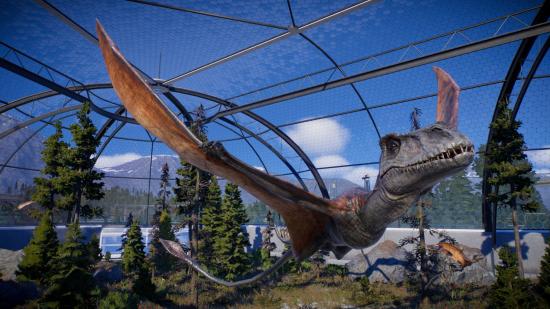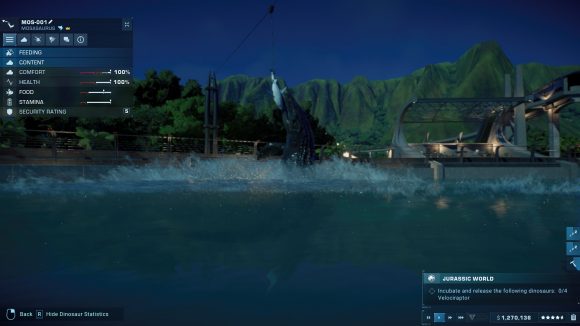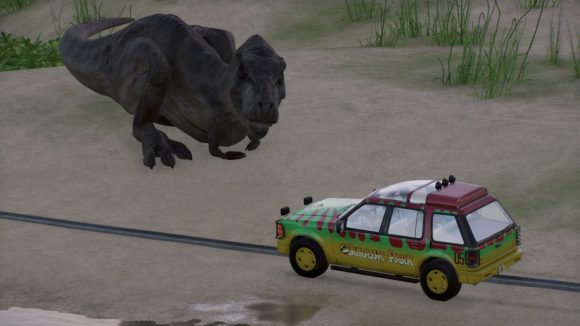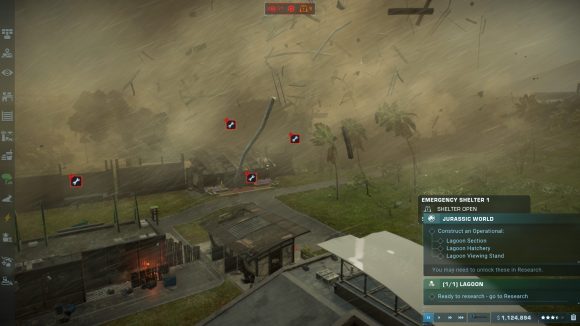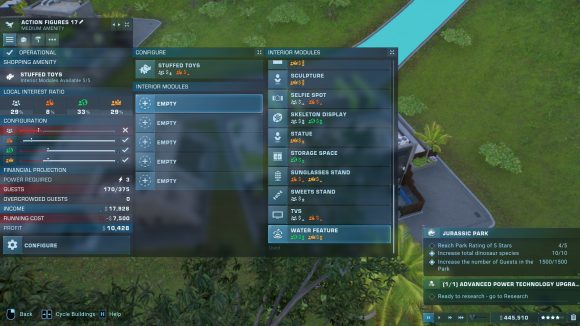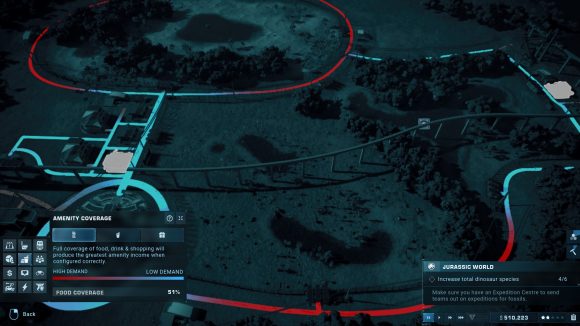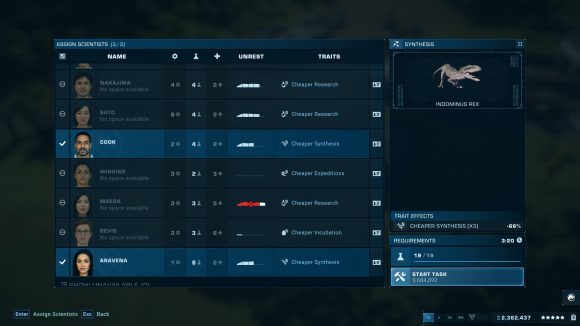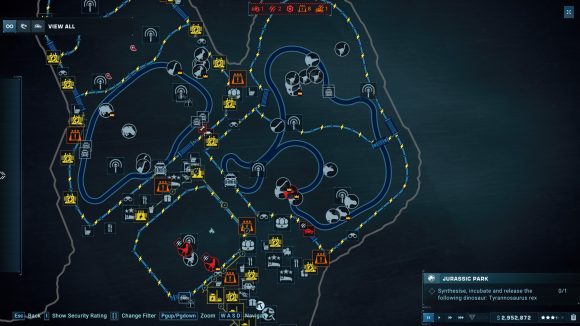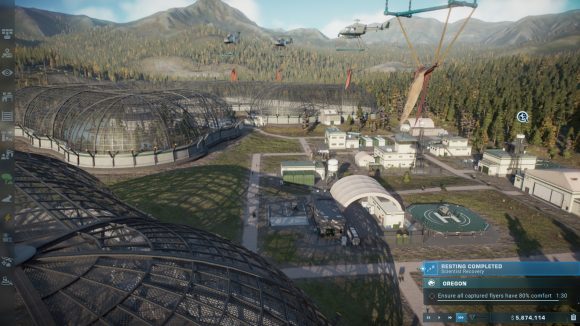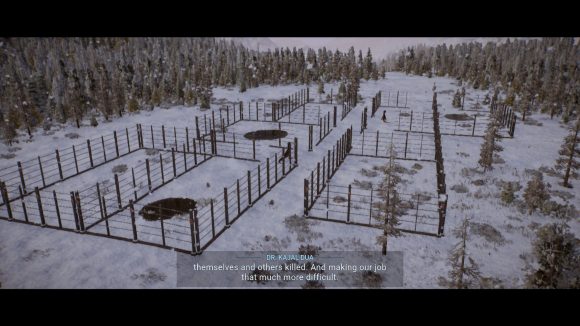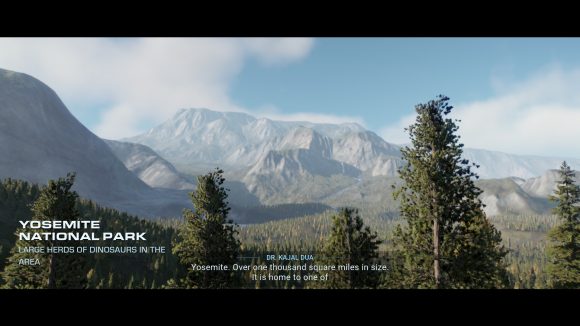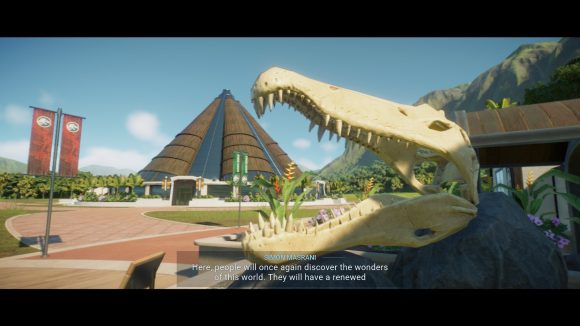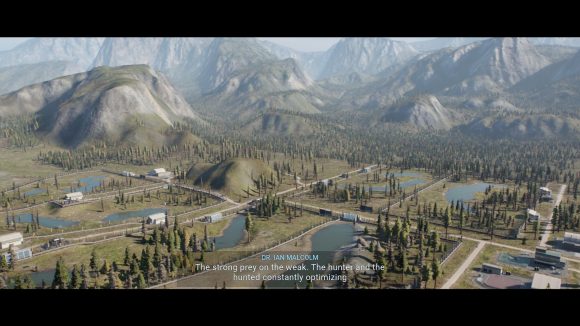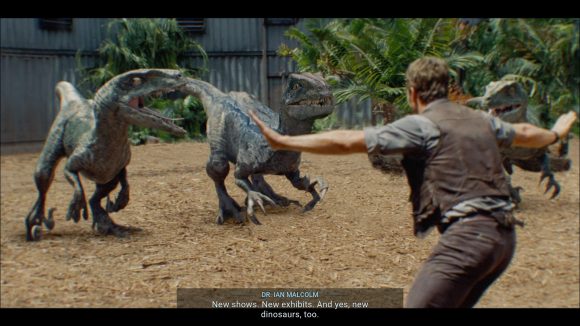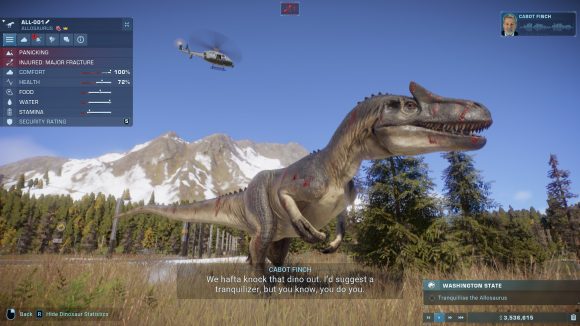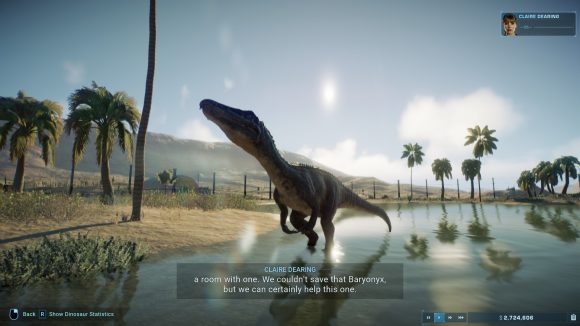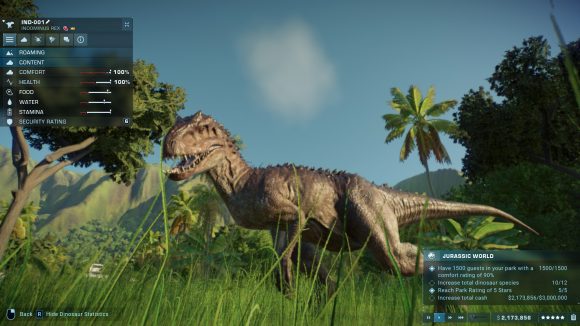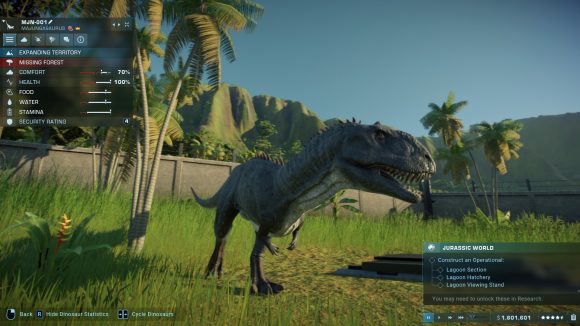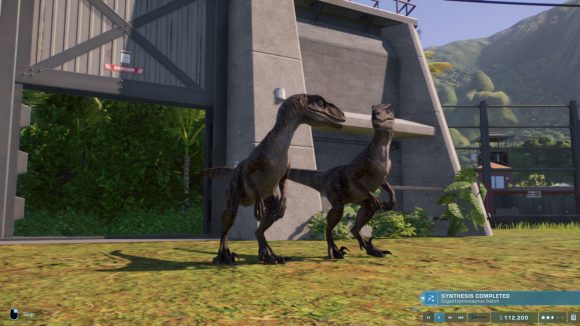Our Verdict
Improves on its predecessor in clever ways and still boasts the most gorgeous dinosaurs ever made in a game. But dealing with disastrous events beyond your control still isn't any fun, even if it's thematic for the Jurassic Park IP.
Jurassic Park is probably the most perfect disaster movie ever made. But Jurassic World Evolution 2 sometimes makes me wish it didn’t depend so much on things going wrong.
It’s understandable that developer Frontier would feel obligated to make horrible things happen to my lovely dinosaur park in order to stay true to the movie, and I get that random calamities have been a thing in this genre since SimCity. But for me, the best management games and dinosaur games have never been about putting out fires. They are bubbling cauldrons of overlapping systems, which organically produce interesting questions of strategy and priority.
There are many more moments like that in Jurassic World Evolution 2 than its predecessor. Smart changes to the core loop have produced a much better, richer management sim. But the one overriding negative is the near-constant, interrupting need to react to short-term emergencies, whether small (a power generator needs refuelling) or large (a catastrophic tornado is ripping up everything I’ve built). Its impact isn’t universal: you can tune the busywork in sandbox mode or slightly mitigate it in-game, and storms are more frequent in some scenarios than others. Nonetheless you will have to deal with them at some point if you want to try everything that JWE2 has to offer.
Chaos Theory is the meat of the game, an exciting new mode with five massive scenarios inspired by each of the Jurassic movies, which simply asks: what if you’d been in charge? As I build my version of the original Jurassic Park, tropical hurricanes frequently cut my power network or destroy fences, unleashing dinosaurs all over the island. I open my emergency shelters so guests can avoid being eaten, but while they’re hiding they’re not spending money, and my overheads are bleeding my account dry. If my balance hits the red, I can’t purchase anything else, including the repairs I need to make the park safe again. In extreme cases, this means that everything can be going well until a storm randomly hits, after which my entire game may be ruined beyond retrieval, through no fault or choice of my own.
After several moments of truly hair-tearing frustration, I simply work around the problem by save scumming, or by leaving enough money sitting idle in the bank to soak up the cost of a storm. These are inelegant, jerry-rigged solutions, but they’re more effective than the ones the game offers. I can research storm protection technology, but it isn’t much help, since it can’t be applied to the facilities that cause the biggest headaches when damaged (namely paddock fences, and the substations that carry power around the park). It’s also expensive and halfway up the tech tree.
I’ve sincerely tried to find the fun in this. I guess there’s a certain pleasure in reacting well to crises, and if you like this sort of thing, you’ll be glad to hear JWE2 demands you jump to put out plenty of other, smaller fires. My problem is that none of the activity that rises from this is interesting; it’s just reaction. When a dinosaur randomly contracts a disease, I simply hotkey to my vet, issue the same routine treatment orders, and return to what I was doing feeling nothing but annoyed. It’s whack-a-mole; a brainless interruption. And it’s a shame, because the rest of JWE2 is good enough to deserve your attention.

The core loop remains largely unchanged: you excavate dinosaur fossils, use their DNA to synthesise ever more impressive new specimens, and release them into your park to attract guests, which you then monetise until your park gets a five-star rating. But smart iterations at each stage of this loop have added a lot of depth.
The three factions from the first game are gone. Your staff are instead represented by individual scientists, whom you’ll dispatch on most of the above tasks. They each have stats and a special skill, and you need to make good decisions in hiring and training in order to overcome some of the steep costs in the late game. After some enjoyable trial and error, my second run at Chaos Theory: Jurassic World is made a lot easier by beelining for every scientist who can get me a discount on these tasks. Synthesising an Indominus Rex for only 600k, rather than two million, feels like a deliciously satisfying hack. Staff sabotage can still occur, but only if you intentionally work them too hard. It’s easy to avoid and you’ll only have yourself to blame if you don’t.
Revisions to guest amenities enable a similar degree of control, and similar sparks of joy. Guests are now subcategorised into four types, each with their own priorities and preferred attractions: luxury lovers want a varied collection of dinosaurs and gyrosphere tours from which to view them, for instance. You can use these attractions to draw particular guests, manipulate their flow around the park, and even cater to their type by adding targeted modules to your shops. Again, figuring out just how much money a well-designed shop in the perfect position can make produces a lovely eureka moment when my revenue skyrockets.
Sometimes guests’ distribution changes so quickly that shops can swing from making a five-figure profit to a four-figure loss, obliging me to monitor and fiddle with their setup every few minutes, which can get a bit tiresome. But this is within my control: as long as my park overall is enticing enough, I can drop some new hotels nearby and shove more guests through the shops’ doors. This is the stuff of good management sims: interesting, dynamic problems that I can solve through understanding and deduction.
The best showcase for these changes is Challenge Mode, in which your goal is to earn a five-star park rating while working against the clock, and some tight limitations. In one scenario set on the English coast, I inherit a broken park with its dinosaurs loose, its facilities scattered across the map, very little money, and almost no starting techs; even basic fences need to be researched. After a few false starts I break even by being ruthless with my spending, hemming in the wild dinosaurs, and shipping them to one central paddock, rather than trying to work with the park’s previous layout. It’s a bite-sized management puzzle, digestible over the course of an evening, that shows the game’s systems at their best.
Campaign mode, by contrast, is largely forgettable. It’s set after the events of Jurassic World Fallen Kingdom: dinosaurs have spread across North America, and it’s up to you to build a number of habitats in which to keep them – and, thereby, us – safe. That’s pretty much it. You don’t get to manage a fully fledged park with guests or amenities, and some interesting musing on the movies’ themes from characters like Ian Malcolm (played by a returning Jeff Goldblum, to everyone’s delight) never solidifies. It’s a pleasant, breezy way to find your feet, but as its prominence on the main menu indicates, Chaos Theory is where you’ll spend most of your time. Each of the two scenarios I completed took me longer than the entire campaign.
Finally, there’s sandbox mode, in which you can manage a park on any of the Challenge or Chaos Theory maps and tune all the game’s systems to your heart’s content. You can get rid of those bastard storms, keep dinosaurs from hurting each other or needing to eat, and even eliminate the need to manage money or power. The catch is you can only play with the toys you unlock elsewhere in the game, but I’m ok with this: it gives you something to work toward, and new maps unlock when you gain a three-star rating in their original mode, which is easy enough even with hurricanes. And since you can keep playing Chaos Theory or Challenge scenarios once you’ve completed them, I can return to a stable environment to unlock new park facilities or dinosaurs at my leisure.
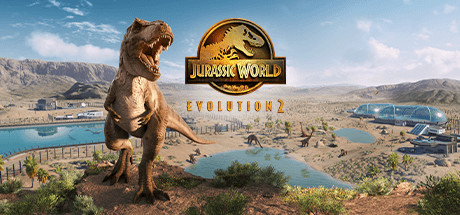 Jurassic World Evolution 2 Jurassic World Evolution 2 $59.99 Buy now Network N earns affiliate commission from qualifying sales.
Jurassic World Evolution 2 Jurassic World Evolution 2 $59.99 Buy now Network N earns affiliate commission from qualifying sales.
Speaking of which. The dinosaurs are, as in the original game, a wonder, and make up for all manner of other frustrations. Frontier has added many new ones, including the much-requested Mosasaurus and other marine reptiles, and deepened their behaviour. All dinosaurs now have more complex preferences for their diet, environment, and stablemates, and though it can be fiddly, it’s also very rewarding to build a paddock that can accommodate an eye-catching menagerie and draw the punters in. Dinosaur behaviour is also more complex, and Frontier has done a superb job communicating your creatures’ personalities and emotions. As I release a baryonyx into its new home, there’s something in the tilt of its head as it looks around that communicates wonderment and curiosity. Velociraptors squint and sneer at each other wickedly when released from the hatchery. T-Rexes even manage to look cute in an almost feline way as they curl up to sleep.
Indeed the game as a whole looks glorious, and you’ll have time to drink it all in. There’s a lot of waiting around in the late game as I save money for some of the more expensive expeditions, which would be a problem if it didn’t provide the perfect opportunity to look around the park a bit. You can even earn money from this by taking photographs with your rangers.
With new depth at every stage in its core loop, Jurassic World Evolution 2 is a much better management sim than its predecessor. By giving you more control over your staff, guests, facilities, and main attractions, it gives you far more tools to steer the course of your park’s future. I would say it makes me feel in control, but then, as Dr Ellie Sattler says in the first movie, “you never have control, that’s the illusion,” in perhaps the most telling statement of Jurassic Park’s big themes. So yes, those immensely annoying hurricanes have their place. That still doesn’t make them fun. Frontier is in a tough spot there.
